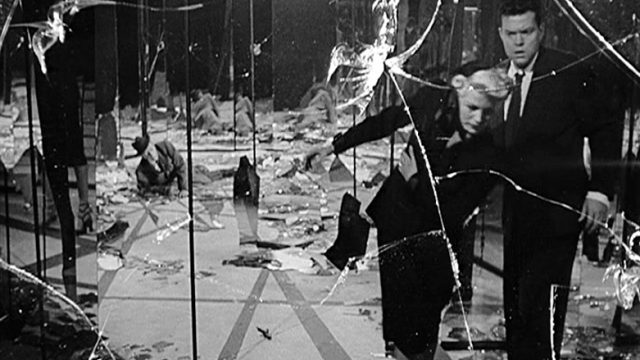Once Orson Welles arguably topped the world of traditional narrative with the triumph of editing and image in Citizen Kane, his directing resisted going backwards. He had films beaten back into a more traditional shape by the studios as with The Magnificent Ambersons and The Stranger, and once he’d shed executive inference entirely his percolating editing ideas would explode gloriously in F for Fake and (posthumously) The Other Side of the Wind.
But years before the latter two, amid Welles’s tumultuous attempts at playing within the Hollywood system, comes The Lady from Shanghai, a movie that Columbia also attempted to reign in and by, all available evidence, failed. They did succeed in destroying a fair amount of expensive footage shot by Welles and mucking with his attempt at a documentary style that relied on long takes shot on wide lenses on location. But if the purpose was to deliver a more conventional film for easy mass consumption, the studio lost the battle. And the only contribution that makes the film a classic while the story spins its wheels is the visual invention of its beleaguered director.
Each scene has been lavished with imaginative texture, using additives as simple as a mesh between bars during a jail visit to maximize the richness in each shot. Welles’s deep backgrounds are in play again and they put to shame the inert back-and-forth between faces that we’re accustomed to in dialog scenes. Even the requisite Court Doesn’t Work That Way scene is shot so dynamically that it doesn’t get tedious. It’s a level of effort not seen again until Charles Laughton’s one-and-done masterpiece The Night of the Hunter and then maybe never again, certainly not in black and white.
I should summarize the plot here but frankly, I’d be summarizing the wikipedia entry. The script deals just the wrong amount of information and keeps the story as frustrating as it is surprising. I have no idea why Michael (Welles) would go on that boat, and only a vague picture of who lured him into the plot or why. Maybe Michael was conning them all since he was clearly only pretending to be Irish, and doing so badly with his unconvincing accent slipping in and out. None of the schemes, real or red herrings, seem like they would stand up to an ounce of scrutiny, and after awhile it’s tempting to cut anything to do with a plot adrift.
The recommended viewing format might be watching on mute, except then you would miss Rita Hayworth’s breathy alto and Everett Sloan’s fearsome antipathy. Throughout the confusion the movie deals to its audience, the performers do a remarkable job keeping their characters focused on… whatever their goal is at any moment and providing a lifeline to the audience. It all culminates in the iconic shootout in a mirror maze, a scene – much like the characters in it – duplicated many times but proving difficult to shoot. It’s here where Welles’s visual and temporal orchestration is finally allowed to rise together and, well, it’s iconic for a reason.


